Juventus have had their most inconsistent season in recent years and it seems like Andrea Pirlo still couldn’t find the best strategy in order to use his players to their strengths and achieve a balance between the lines. This led to them strolling out of the Serie A top three and found them fighting for a Champions League spot next year.
On the other side, Atalanta have been performing solidly, moving into a direct fight with Milan and Napoli for the second place, showing a winning mentality and drive for improvement, after Inter gave no chance to either of them to pursue the title.
Winning the Coppa Italia title was Juventus’ only secure way for saving their season after a scare that they’ll finish the season without a single achievement and out of the Champions League spots having in mind the intense battle for the top places in Serie A.
For Atalanta, it was a chance to get a reward for their hard work over the past few years, which saw them become a constant threat to the biggest clubs in Italy.
The final started well for the Bergamo team who produced many chances and were dictating the tempo but couldn’t take advantage of Juventus’ errors. The Bianconeri seemed disorganised in the first half, which led to a few missed opportunities and defensive vulnerability, resulting in 1-1 on half-time.
Juventus stepped up after the break and took the initiative, looking way more confident on the ball and managing to exploit Atalanta’s weaknesses well, which led to them taking the 2-1 lead and winning the Coppa Italia, making sure they’ll not be without a trophy this season.
This tactical analysis will examine both teams’ tactics and look if Juventus’ second-half improvement was just a mentality switch or they proved tactical flexibility with it.
Line-ups and formations
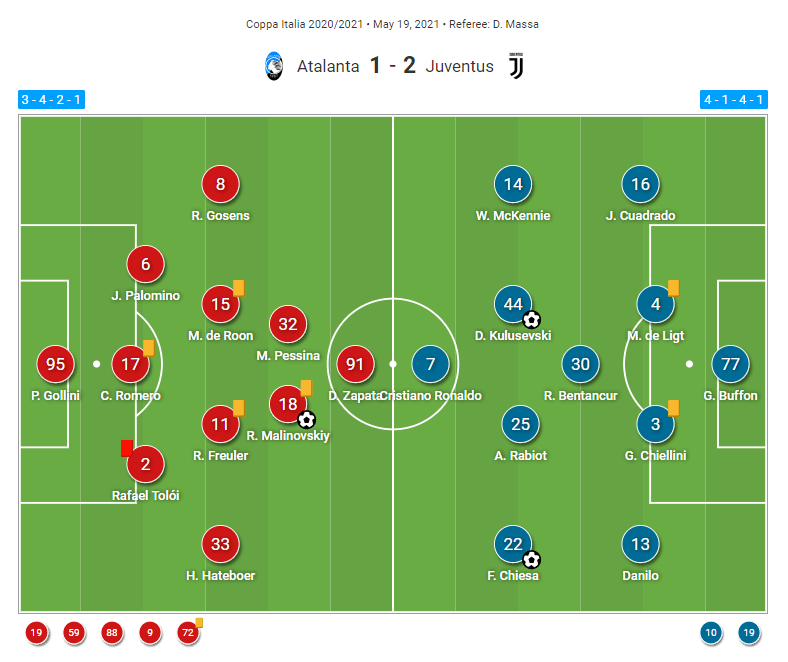
Gian Piero Gasperini lined Atalanta up in their usual 3-4-2-1 with Pierluigi Gollini on the goal, suppored by the centre-backs José Luis Palomino, Cristian Romero and Rafael Tolói. Robin Gosens and Hans Hateboer were employed as wing-backs as per usual, while Marten de Roon and Remo Freuler covered the central areas.
In attack, Matteo Pessina and Ruslan Malinovskiy made sure to support Duván Zapata, both moving out wide in efforts to create short pass combinations and bypass Juve’s defenders.
Out of possession, they’d drop additional men in defence, trying to cover the wings where the Bianconeri focused their attacking actions.
Pirlo employed more of a 4-1-4-1 formation (which on many occasions transformed into 3-5-2) with the veteran Gianluigi Buffon between the posts. The four-men defensive line consisted of Daino, Giorgio Chiellini, Matthijs De Ligt and Juan Cuadrado.
Rodrigo Bentancur and Adrien Rabiot occupied the central midfield, while Federico Chiesa and Weston McKennie covered the half-spaces and provided more options out wide. In attack, the manager relied on Cristiano Ronaldo centrally and Dejan Kulusevski, who would be their key threat on the right throughout the game. The team focused their attacking actions on the right-wing, where many of their chances came from, although they created a few successful counter-attacks by exposing the opposition through the central areas.
Atalanta’s first-half dominance and pressing efforts
Atalanta set the tempo in the first half through their pressing efforts off the ball and their positioning when in possession. They were focused on having more of the ball and exploiting the opposition through the flanks. Gosens and Hateboer were crucial for the execution of their attacking strategy and for creating combinations on both sides in order to progress the ball.
La Dea would often overload the right side and drag the whole Juventus team to these areas, only to use Pessina’s as a passing outlet centrally in efforts to switch play to the underloaded left side where Gosens would move forward off the ball. This way the team were able to create attacking triangles between Gosens, Pessina and Zapata. De Ligt and Cuadrado were instructed to cover the Colombian tightly and Pessina’s presence in these areas was very important in order to drag them out and provide space for the forward.
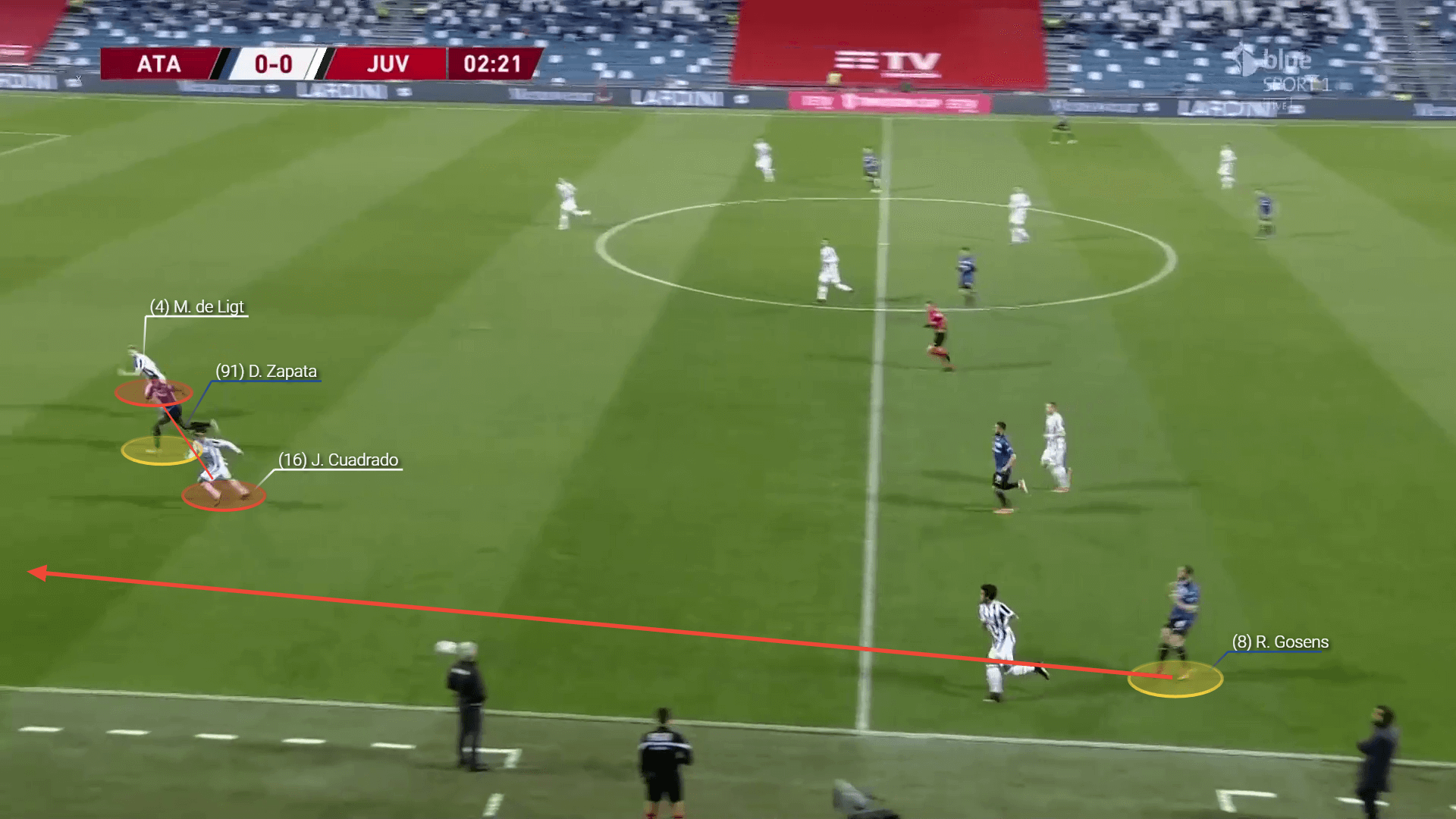
Danilo managed to limit Hateboer’s movement quite well and this made the switch of play a necessary step for Atalanta if they wanted to create more chances on the goal. This was important as Malinovskyi’s positioning in the half-spaces and Hateboer’s tendency to cut inside would be a constant threat to the goal.
Luckily for them, Gosens won the battle against Cuadrado in the first half which led to a lot of trouble for Juventus, since the individual errors often allowed Atalanta to create chances from these areas. When it comes to De Ligt, he was often unable to cover Zapata properly as the Colombian’s movement off the ball is very strong and he was able to escape his marker on a few occasions.
When in possession, Juventus tend to build up from the back with the defensive line moving closer to the central line. Atalanta did allow this but focused their pressing efforts on blocking the passing lanes and setting a barrier between Juve’s lines.
The Bianconeri were aiming to attack at all times which often resulted in having six players in the advanced areas, while Bentancur was the only passing outlet centrally. La Dea’s man-to-man marking strategy though was key for them to control Juve’s higher positioning and stop them from creating chances despite the overload in the final third.
Atalanta averaged a PPDA rate of 7.94 which they tried to keep up with throughout the game and were successful at, due to Juventus giving away the initiative. In the second half though, things changed as the Bianconeri increased their press intensity to adjust to the opposition. This forced the Bergamo team to step back and it immediately affected their press intensity. Their PPDA increased and it eventually led to Juve’s second goal.
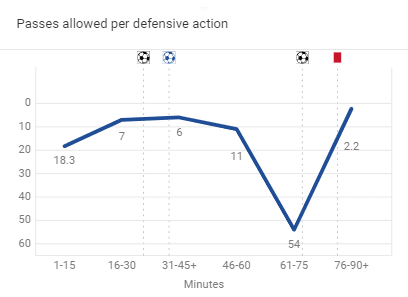
Pirlo’s half-time talk
Despite the 1-1 result on the break, it seemed that Juventus didn’t have a Plan B in the first half, being the way less active team and failing both in attack and defence. Atalanta’s efforts to block their movement and creativity in the advanced areas were successful and they kept the Bianconeri away from the goal.
On the other side, Pirlo’s side failed to cover the wide areas properly and that led to a lot of conceded attacks and expectedly many crossing attempts from Atalanta. The team needed to change their strategy in the second half if they wanted to protect Buffon’s goal better and also create more opportunities upfront.
And it seems like Pirlo had a plan for how to achieve that because Juventus went out with a completely different face in the second half. They fought for every ball and improved their defensive organisation. Their marking strategy kept La Dea away from the goal, while they increased the creativity in their build-up and implemented positional changes in efforts to progress the ball and penetrate.
He made two crucial changes in Juventus’ tactics:
Change of press intensity and defensive organisation
The ex-Juventus star changed a lot when it comes to the team’s defensive organisation. Their pressing intensity increased immensely and they focused on troubling Atalanta’s build-up with explicit man-to-man marking. They methodically decreased their PPDA and started pressing the players with the ball more aggressively while improving their positioning in efforts to block the passing lanes and recover the ball as quickly as possible. They limited the spaces between the lines and relied on more compactness which prevented Atalanta from doing their usual rotations and made it more difficult for them to successfully progress the ball to the final third.
Each player was assigned defensive duties and they often created 1vs2 situations in efforts to pressurise the opposition and block their ways forward. The limitation of space and the constant pressure made it difficult for Atalanta to employ their usual attacking strategy. Zapata, who usually has very strong aerial presence didn’t win any of his six aerial duels which took off of La Dea’s efficiency in front of the goal. Seeing that Pirlo adjusted his tactics and Atalanta gave away the initiative, he introduced Luis Muriel, Mario Pašalić and Josip Iličić for Malinovskyi, Pessina and Hateboer but they failed to get time on the ball and were quite isolated trying to drop back and pick up the ball.
In the occasions where La Dea were able to deliver the ball in the advanced areas, Juventus were better prepared by constantly dropping a fifth man in defence and looking to cover depth whenever any of the defenders was dragged out of position. Their aerial presence in the central areas improved too and they were able to hold onto the ball in key moments.
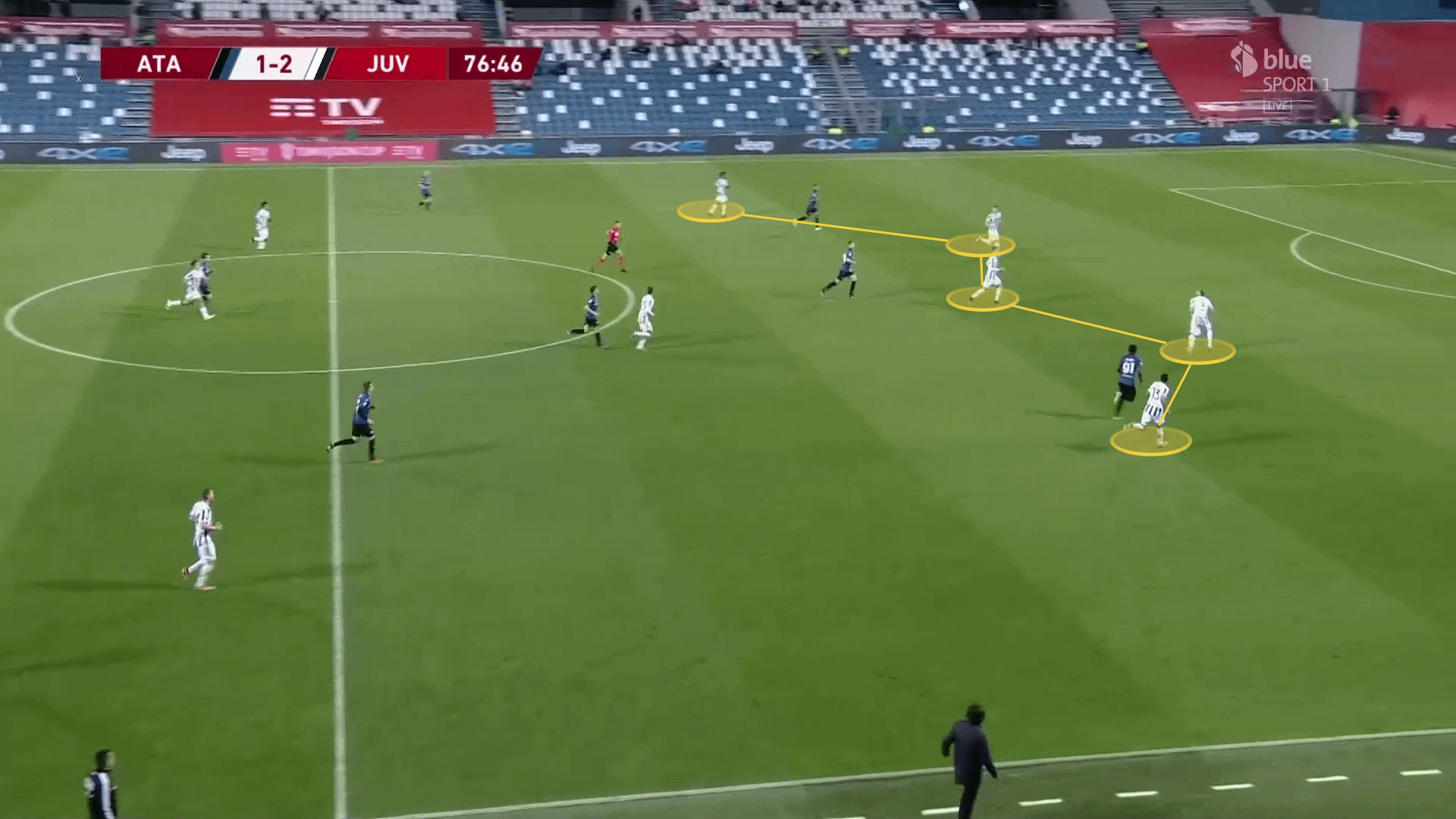
Bentancur’s defensive actions were key for the team during transitions. His ball recovery efforts helped the team in keeping the opposition away from their defensive third. He recovered the ball 19 times and was key for blocking Atalanta’s efforts centrally.
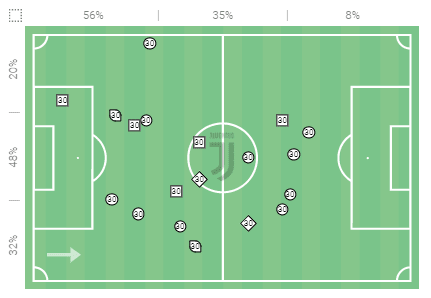
Setting the team in a more straight 3-5-2 in possession allowed them to create better quality opportunities up front too.
Change of attacking strategy
The team still looked to overload the advanced areas but they put more consideration into their positioning in the second half. By replicating the positional changes and the movement that Atalanta usually do, Juventus increased their creativity and moved better in and around the box. Key to their attacking success was the exploration of the half-spaces and their constant movement off the ball, which led to quality one-touch combinations. Their movement in the half-spaces would often drag Atalanta’s players out of position. That’s when the Bianconeri would make runs to the uncovered areas and create goalscoring opportunities. Once the Black and Whites included more movement in the final third it was difficult for La Dea to keep their defensive shape. This forced them to go out into 1vs1 situations which eventually led to individual errors – an issue that Atalanta often experience against attack-minded opposition.
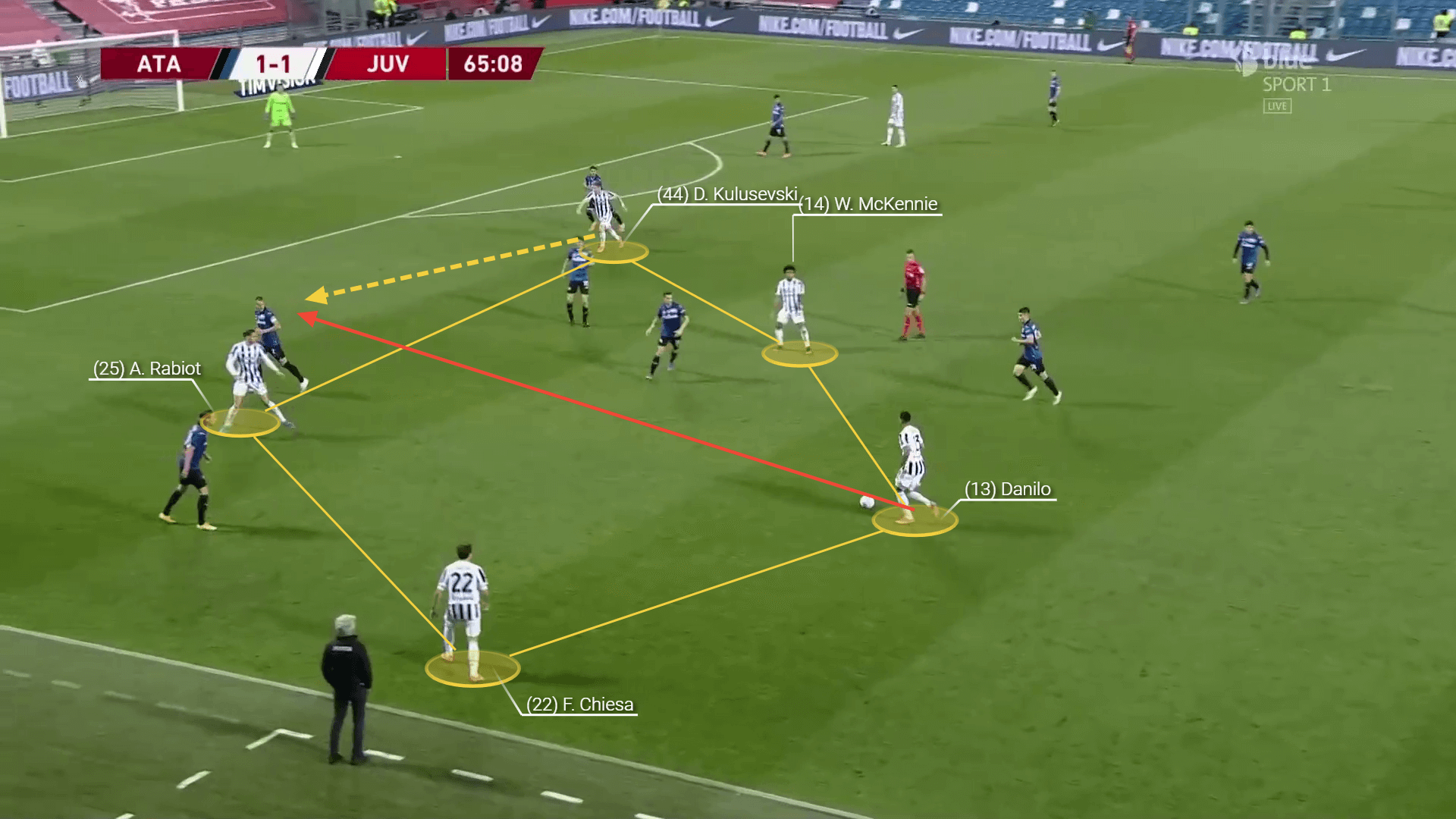
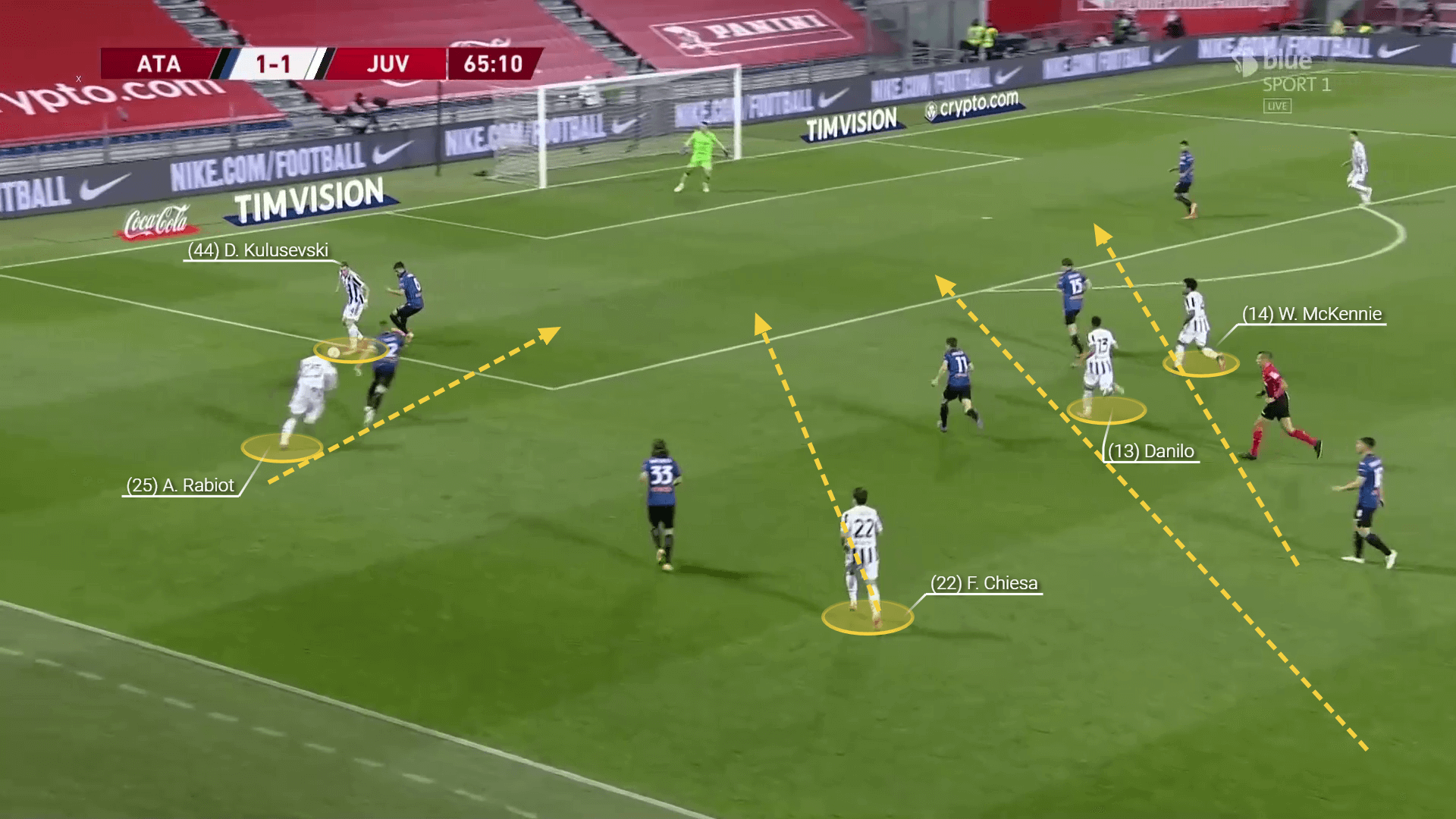
Juventus also implemented long diagonal balls into their attacking strategy. This helped them to bypass the opposition’s press by dragging them towards the ball carrier and then delivering a diagonal ball directly to the final third, where they have created a numerical advantage.
Conclusion
As our analysis showed, Pirlo showed the needed awareness and tactical flexibility and reacted smartly to the first half events. While often criticised for his uncertain strategy and inconsistent formations, this time this tilted the scales in his favour as he was unpredictable. On the other side, Atalanta, who rely on their strong connection and have a distinguished strategy were quite predictable despite the substitutions in the second half, which allowed Juventus to surprise them with a more aggressive approach to triumph with the title.






Comments